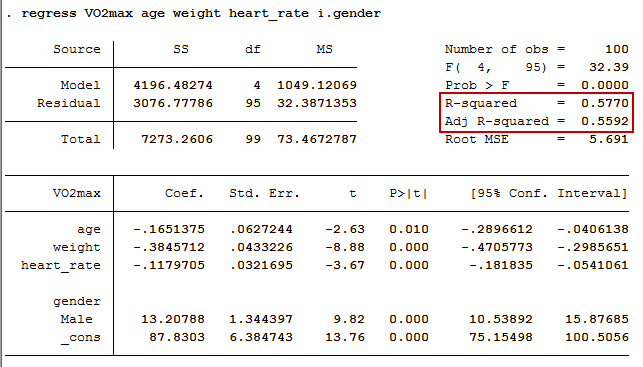

Perform F-Test to determine whether we can reject the null hypothesis at a 1% level of significance. Let’s say we have two data sets A & B which contains different data points.
#F TEST STATA DOWNLOAD#
doi: 10.3102/00346543051004499.You can download this F-TEST Formula Excel Template here – F-TEST Formula Excel Template F-Test Formula – Example #1 "A reaction to 'Consequences of failure to meet assumptions underlying the fixed effects analysis of variance and covariance' ". "Fermat, Schubert, Einstein, and Behrens–Fisher:The Probable Difference Between Two Means When σ 1 2 ≠ σ 2 2", Journal of Modern Applied Statistical Methods, 1(2), 461–472. "Conditions for the Effectiveness of a Preliminary Test of Variance".
 ^ Markowski, Carol A Markowski, Edward P. (1995) Continuous Univariate Distributions, Volume 2, Wiley. ^ Johnson, N.L., Kotz, S., Balakrishnan, N. (1989), Statistical Methods, Eighth Edition, Iowa State University Press. This is the problem treated by Hartley's test and Bartlett's test. The immediate generalization of the problem outlined above is to situations where there are more than two groups or populations, and the hypothesis is that all of the variances are equal. However, for large alpha levels (e.g., at least 0.05) and balanced layouts, the F-test is relatively robust, although (if the normality assumption does not hold) it suffers from a loss in comparative statistical power as compared with non-parametric counterparts. These F-tests are generally not robust when there are violations of the assumption that each population follows the normal distribution, particularly for small alpha levels and unbalanced layouts. ) F-tests for the equality of variances can be used in practice, with care, particularly where a quick check is required, and subject to associated diagnostic checking: practical text-books suggest both graphical and formal checks of the assumption.į-tests are used for other statistical tests of hypotheses, such as testing for differences in means in three or more groups, or in factorial layouts. (However, all of these tests create experiment-wise type I error inflations when conducted as a test of the assumption of homoscedasticity prior to a test of effects. This F-test is known to be extremely sensitive to non-normality, so Levene's test, Bartlett's test, or the Brown–Forsythe test are better tests for testing the equality of two variances. The null hypothesis is rejected if F is either too large or too small based on the desired alpha level (i.e., statistical significance). Otherwise it follows an F-distribution scaled by the ratio of true variances. Has an F-distribution with n − 1 and m − 1 degrees of freedom if the null hypothesis of equality of variances is true. X ¯ = 1 n ∑ i = 1 n X i and Y ¯ = 1 m ∑ i = 1 m Y i The expected values for the two populations can be different, and the hypothesis to be tested is that the variances are equal.
^ Markowski, Carol A Markowski, Edward P. (1995) Continuous Univariate Distributions, Volume 2, Wiley. ^ Johnson, N.L., Kotz, S., Balakrishnan, N. (1989), Statistical Methods, Eighth Edition, Iowa State University Press. This is the problem treated by Hartley's test and Bartlett's test. The immediate generalization of the problem outlined above is to situations where there are more than two groups or populations, and the hypothesis is that all of the variances are equal. However, for large alpha levels (e.g., at least 0.05) and balanced layouts, the F-test is relatively robust, although (if the normality assumption does not hold) it suffers from a loss in comparative statistical power as compared with non-parametric counterparts. These F-tests are generally not robust when there are violations of the assumption that each population follows the normal distribution, particularly for small alpha levels and unbalanced layouts. ) F-tests for the equality of variances can be used in practice, with care, particularly where a quick check is required, and subject to associated diagnostic checking: practical text-books suggest both graphical and formal checks of the assumption.į-tests are used for other statistical tests of hypotheses, such as testing for differences in means in three or more groups, or in factorial layouts. (However, all of these tests create experiment-wise type I error inflations when conducted as a test of the assumption of homoscedasticity prior to a test of effects. This F-test is known to be extremely sensitive to non-normality, so Levene's test, Bartlett's test, or the Brown–Forsythe test are better tests for testing the equality of two variances. The null hypothesis is rejected if F is either too large or too small based on the desired alpha level (i.e., statistical significance). Otherwise it follows an F-distribution scaled by the ratio of true variances. Has an F-distribution with n − 1 and m − 1 degrees of freedom if the null hypothesis of equality of variances is true. X ¯ = 1 n ∑ i = 1 n X i and Y ¯ = 1 m ∑ i = 1 m Y i The expected values for the two populations can be different, and the hypothesis to be tested is that the variances are equal. 
Let X 1, ., X n and Y 1, ., Y m be independent and identically distributed samples from two populations which each has a normal distribution.







 0 kommentar(er)
0 kommentar(er)
